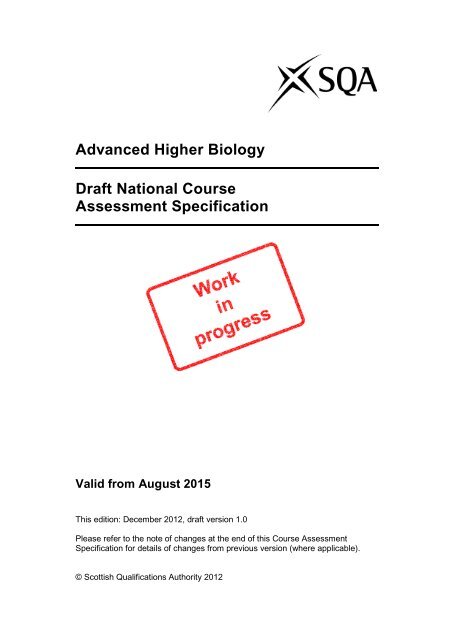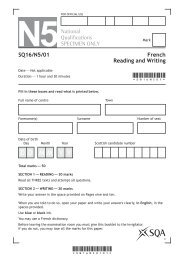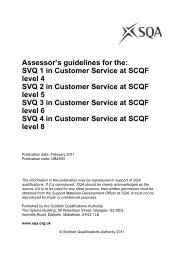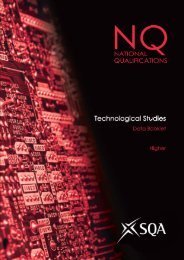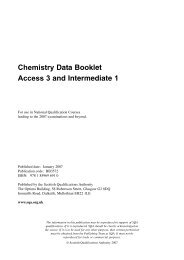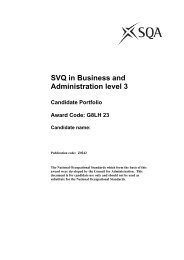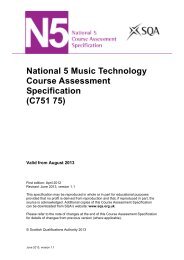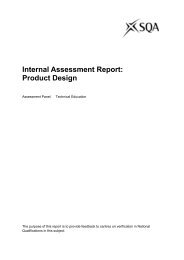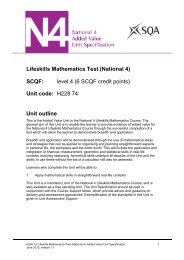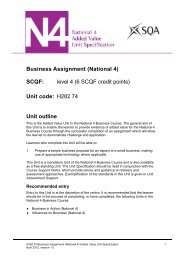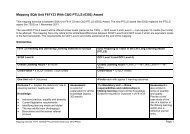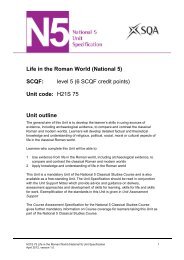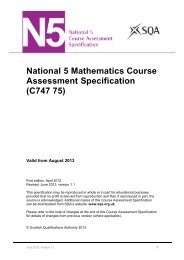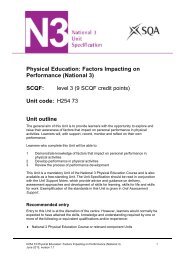Advanced Higher Biology Draft National Course Assessment ...
Advanced Higher Biology Draft National Course Assessment ...
Advanced Higher Biology Draft National Course Assessment ...
You also want an ePaper? Increase the reach of your titles
YUMPU automatically turns print PDFs into web optimized ePapers that Google loves.
<strong>Advanced</strong> <strong>Higher</strong> <strong>Biology</strong><br />
<strong>Draft</strong> <strong>National</strong> <strong>Course</strong><br />
<strong>Assessment</strong> Specification<br />
Valid from August 2015<br />
This edition: December 2012, draft version 1.0<br />
Please refer to the note of changes at the end of this <strong>Course</strong> <strong>Assessment</strong><br />
Specification for details of changes from previous version (where applicable).<br />
© Scottish Qualifications Authority 2012
Contents<br />
<strong>Course</strong> outline 1<br />
<strong>Course</strong> assessment structure 1<br />
Equality and inclusion 1<br />
<strong>Assessment</strong> 2<br />
<strong>Course</strong> assessment 2<br />
Added value 2<br />
Grading 2<br />
Structure and coverage of the <strong>Course</strong> assessment 4<br />
Setting, conducting and marking of assessment 6<br />
Further mandatory information on <strong>Course</strong> coverage 7<br />
Administrative information 12<br />
History of changes to <strong>Course</strong> <strong>Assessment</strong> Specification 12
<strong>Course</strong> outline<br />
<strong>Course</strong> title:<br />
SCQF level:<br />
<strong>Course</strong> code:<br />
<strong>Course</strong> assessment code:<br />
<strong>Advanced</strong> <strong>Higher</strong> <strong>Biology</strong><br />
7 (32 SCQF credit points)<br />
to be advised<br />
to be advised<br />
The purpose of the <strong>Course</strong> <strong>Assessment</strong> Specification is to ensure consistent and<br />
transparent assessment year on year. It describes the structure of the <strong>Course</strong><br />
assessment and the mandatory skills, knowledge and understanding that will be<br />
assessed.<br />
<strong>Course</strong> assessment structure<br />
Component 1 — question paper<br />
Component 2 — project<br />
Total marks<br />
100 marks<br />
30 marks<br />
130 marks<br />
This <strong>Course</strong> includes eight SCQF credit points to allow additional time for<br />
preparation for <strong>Course</strong> assessment. The <strong>Course</strong> assessment covers the added<br />
value of the <strong>Course</strong>.<br />
Equality and inclusion<br />
This <strong>Course</strong> <strong>Assessment</strong> Specification has been designed to ensure that there<br />
are no unnecessary barriers to assessment. <strong>Assessment</strong>s have been designed<br />
to promote equal opportunities while maintaining the integrity of the qualification.<br />
For guidance on assessment arrangements for disabled learners and/or those<br />
with additional support needs, please follow the link to the <strong>Assessment</strong><br />
Arrangements web page: www.sqa.org.uk/sqa/14977.html.<br />
Guidance on inclusive approaches to delivery and assessment of this <strong>Course</strong> is<br />
provided in the <strong>Course</strong> Support Notes.<br />
December 2012, draft version 1.0 1
<strong>Assessment</strong><br />
To gain the award of the <strong>Course</strong>, the learner must pass all the Units as well as<br />
the <strong>Course</strong> assessment. <strong>Course</strong> assessment will provide the basis for grading<br />
attainment in the <strong>Course</strong> award.<br />
<strong>Course</strong> assessment<br />
SQA will produce and give instructions for the production and conduct of <strong>Course</strong><br />
assessments based on the information provided in this document.<br />
Added value<br />
The purpose of the <strong>Course</strong> assessment is to assess added value of the <strong>Course</strong><br />
as well as confirming attainment in the <strong>Course</strong> and providing a grade. The added<br />
value for the <strong>Course</strong> will address the key purposes and aims of the <strong>Course</strong>, as<br />
defined in the <strong>Course</strong> Rationale. It will do this by addressing one or more of<br />
challenge, or application.<br />
In this <strong>Course</strong> assessment, added value will focus on the following:<br />
♦ challenge — requiring greater depth or extension of knowledge and/or skills<br />
♦ application — requiring application of knowledge and/or skills in practical or<br />
theoretical contexts as appropriate<br />
This added value consists of:<br />
♦ a question paper, which requires learners to demonstrate aspects of<br />
challenge and application; learners will apply breadth and depth of skills,<br />
knowledge and understanding from across the <strong>Course</strong> to answer questions in<br />
biology<br />
♦ a project which requires learners to demonstrate aspects of challenge and<br />
application; learners will apply skills of scientific inquiry, using related<br />
knowledge, to carry out a meaningful and appropriately challenging task in<br />
biology and communicate findings<br />
Grading<br />
<strong>Course</strong> assessment will provide the basis for grading attainment in the <strong>Course</strong><br />
award.<br />
The <strong>Course</strong> assessment is graded A–D. The grade is determined on the basis of<br />
the total mark for all <strong>Course</strong> assessments together.<br />
A learner’s overall grade will be determined by their performance across the<br />
<strong>Course</strong> assessment.<br />
December 2012, draft version 1.0 2
Grade description for C<br />
For the award of Grade C, learners will have demonstrated successful<br />
performance in all of the Units of the <strong>Course</strong>. In the <strong>Course</strong> assessment, learners<br />
will typically have demonstrated successful performance in relation to the<br />
mandatory skills, knowledge and understanding for the <strong>Course</strong>, by:<br />
♦ retaining knowledge and scientific skills over an extended period of time<br />
♦ integrating knowledge and understanding, and scientific skills, acquired<br />
through the study of the component Units<br />
♦ applying knowledge and understanding and scientific skills set in contexts<br />
similar to those associated with the component Units<br />
♦ applying knowledge and understanding, and scientific skills, to solve<br />
problems<br />
♦ selecting, analysing and presenting relevant information collected through<br />
experimental, observational or research work<br />
♦ reporting in a scientific manner which communicates the biology relating to<br />
the <strong>Course</strong><br />
Grade description for A<br />
For the award of Grade A, learners will have demonstrated successful<br />
performance in all of the Units of the <strong>Course</strong>. In the <strong>Course</strong> assessment, learners<br />
will typically have demonstrated a high level of performance in relation to the<br />
mandatory skills, knowledge and understanding for the <strong>Course</strong>.<br />
In addition, learners achieving a Grade A will have demonstrated a high overall<br />
level of performance by:<br />
♦ retaining an extensive range of knowledge and scientific skills over an<br />
extended period of time<br />
♦ integrating an extensive range of knowledge and understanding and scientific<br />
skills acquired across the component Units<br />
♦ applying knowledge and understanding and scientific skills in less familiar<br />
and/or more complex contexts than in the component Units<br />
♦ integrating knowledge and understanding and scientific skills to solve<br />
problems in less familiar and/or more complex contexts<br />
♦ showing proficiency in selecting, analysing and presenting relevant<br />
information collected through experimental, observational or research work<br />
♦ showing proficiency in reporting in a scientific manner that communicates the<br />
biology relating to the <strong>Course</strong> by analysing and interpreting information in a<br />
critical and scientific manner and demonstrating depth of knowledge and<br />
understanding<br />
Credit<br />
To take account of the extended range of learning and teaching approaches,<br />
remediation, consolidation of learning and integration needed for preparation for<br />
external assessment, six SCQF credit points are available in <strong>Course</strong>s at<br />
<strong>National</strong> 5 and <strong>Higher</strong>, and eight SCQF credit points in <strong>Course</strong>s at <strong>Advanced</strong><br />
<strong>Higher</strong>. These points will be awarded when a Grade D or better is achieved.<br />
December 2012, draft version 1.0 3
Structure and coverage of the <strong>Course</strong> assessment<br />
The <strong>Course</strong> assessment will consist of two Components: a question paper and a<br />
project.<br />
Component 1 — question paper<br />
The purpose of the question paper is to assess breadth and depth of knowledge<br />
and understanding from across the Units.<br />
The paper will assess scientific inquiry skills and analytical thinking skills. The<br />
paper will give learners an opportunity to demonstrate the following skills,<br />
knowledge and understanding by:<br />
♦ demonstrating knowledge and understanding of biology by making<br />
statements, describing information, providing explanations and integrating<br />
knowledge<br />
♦ applying knowledge of biology to new situations, interpreting information and<br />
solving problems<br />
♦ planning or designing experiments/investigations, including safety measures,<br />
to test given hypotheses or to illustrate particular effects<br />
♦ selecting and presenting information appropriately in a variety of forms<br />
♦ processing information (using calculations and units, where appropriate)<br />
♦ making predictions and generalisations based on evidence/information<br />
♦ drawing valid conclusions and giving explanations supported by<br />
evidence/justification<br />
♦ identifying a source of error and suggesting improvements to experiments<br />
The mandatory skills and knowledge are specified in the ‘Further mandatory<br />
information on <strong>Course</strong> coverage’ section at the end of this <strong>Course</strong> <strong>Assessment</strong><br />
Specification.<br />
The question paper will have 100 marks (77% of the total mark).<br />
The question paper will have two Sections.<br />
Section A will contain objective questions and will have 20 marks.<br />
Section B will contain restricted and extended response questions and will have<br />
80 marks.<br />
Marks will be distributed approximately proportionately across the Units.<br />
The majority of the marks will be awarded for applying knowledge and<br />
understanding. The other marks will be awarded for applying scientific inquiry<br />
and problem solving skills.<br />
Component 2 — project<br />
The purpose of the project is to allow the learner to carry out an in-depth study of<br />
a biology topic. The topic will be chosen by the learner, who will individually<br />
investigate/research the underlying biology. This is an open-ended task which<br />
may involve a significant part of the work being carried out without close<br />
supervision. The learner will extend and apply the skills of<br />
independent/autonomous working. This includes making independent and<br />
rational decisions based on evidence and interpretation of scientific information,<br />
December 2012, draft version 1.0 4
and the analysis and evaluation of their results. This will further develop and<br />
enhance their scientific literacy.<br />
The project will assess the application of skills of scientific inquiry and related<br />
biology knowledge and understanding.<br />
The project will have 30 marks (23% of the total marks).<br />
The majority of the marks will be awarded for applying scientific inquiry skills. The<br />
other marks will be awarded for applying related knowledge and understanding.<br />
In preparation for the assessment, the learner will:<br />
♦ select an appropriate biology topic within the set guidelines provided by SQA<br />
♦ plan the project<br />
♦ investigate/research the topic<br />
♦ process the information/data collected<br />
♦ review and evaluate their findings<br />
♦ produce a scientific report<br />
The learner will then submit their project report as evidence.<br />
The project report will be externally assessed using the following assessment<br />
categories:<br />
(a) Underlying biology<br />
(b) Procedures<br />
(c) Results<br />
(d) Conclusion<br />
(e) Evaluation<br />
(f) Presentation<br />
December 2012, draft version 1.0 5
Setting, conducting and marking of assessment<br />
Question paper<br />
This question paper will be set and marked by SQA, and conducted in centres<br />
under conditions specified for external examinations by SQA. Learners will<br />
complete this in 2 hours and 30 minutes.<br />
Controlled assessment — project<br />
This project is:<br />
♦ set by centres within SQA guidelines<br />
♦ conducted under some supervision and control<br />
The production of evidence for the project will be conducted:<br />
♦ in time to meet a submission date set by SQA<br />
♦ independently by the learner<br />
Evidence will be submitted to SQA for external marking.<br />
All marking will be quality assured by SQA.<br />
December 2012, draft version 1.0 6
Further mandatory information on <strong>Course</strong> coverage<br />
The following gives details of mandatory skills, knowledge and understanding for<br />
the <strong>Advanced</strong> <strong>Higher</strong> <strong>Biology</strong> <strong>Course</strong>. <strong>Course</strong> assessment will involve sampling<br />
the skills, knowledge and understanding. This list of skills, knowledge and<br />
understanding also provides the basis for the assessment of Units of the <strong>Course</strong>.<br />
The following gives details of the skills:<br />
♦ extending and applying knowledge of biology to new situations, interpreting<br />
and analysing information to solve more complex problems<br />
♦ planning and designing biological experiments/investigations, using reference<br />
material and including risk assessments, to test a hypothesis or to illustrate<br />
particular effects<br />
♦ carrying out complex experiments in biology safely, recording systematic<br />
detailed observations and collecting data<br />
♦ selecting and presenting detailed information appropriately in a variety of<br />
forms<br />
♦ processing and analysing biological information (using calculations,<br />
significant figures and units, where appropriate)<br />
♦ making reasoned predictions and generalisations from a range of<br />
evidence/information<br />
♦ drawing valid conclusions and giving explanations supported by<br />
evidence/justification<br />
♦ critically evaluating experimental procedures by identifying sources of error,<br />
suggesting and implementing improvements<br />
♦ drawing on knowledge and understanding of biology to make accurate<br />
statements, describe complex information, provide detailed explanations and<br />
integrate knowledge<br />
♦ communicating biological findings/information fully and effectively<br />
♦ analysing and evaluating scientific publications and media reports<br />
These skills will be assessed, across the <strong>Course</strong>, in the context of the mandatory<br />
knowledge.<br />
The following table provides further detail of the mandatory knowledge for the<br />
<strong>Advanced</strong> <strong>Higher</strong> <strong>Biology</strong> <strong>Course</strong>.<br />
December 2012, draft version 1.0 7
Unit 1 — Cells and proteins<br />
1 Laboratory techniques for biologists<br />
(a) Health and safety. Identifying and controlling hazards. The use of control<br />
measures including personal protective equipment.<br />
(b) Liquids and solutions. Dilution series. Standard curve and determination of<br />
an unknown. Use of colorimeters. Buffers and pH.<br />
(c) Separation techniques.<br />
Centrifugation, paper, thin layer and affinity chromatography, protein<br />
electrophoresis, separation of proteins and iso-electric points.<br />
(d) Antibody techniques.<br />
Detection and identification of specific proteins. Immunoassay techniques.<br />
Fluorescent labelling of antibodies in blotting and staining of tissues. Production<br />
and use of monoclonal antibodies.<br />
(e) Microscopy.<br />
Bright field and fluorescence. Haemocytometers and flow cytometry.<br />
(f) Cell culture and aseptic technique.<br />
Use of inoculum, explants or cells. Viable and total cell counts. Lifetime of<br />
primary cell lines and cancer cell lines. Complex media for animal and plant cell<br />
culture.<br />
2 Proteins<br />
a) Proteomics<br />
The proteome and its complexity. RNA splicing and post-translational<br />
modification. Regulation of gene expression. Limitations of DNA sequencing and<br />
microarray technology.<br />
(b) Protein structure, binding and conformational change.<br />
(i) Amino acid sequence and protein structure.<br />
Primary sequence. The main classes of R groups and interactions in secondary<br />
and tertiary structure. Influence of temperature and pH on R group interactions.<br />
Prosthetic groups. Quaternary structure.<br />
(ii) Hydrophobic and hydrophilic interactions and the location of cellular proteins.<br />
Role of R groups in the distribution of soluble, globular, integral membrane and<br />
peripheral membrane proteins.<br />
(iii) Binding to ligands.<br />
Involvement of R groups in ligand binding. Proteins and DNA binding<br />
interactions including histones and transcription regulation.<br />
(iv) Effect of binding on the conformation of a protein, including functional<br />
change in the protein; substrate binding and induced fit. Activation energy,<br />
allosteric enzymes, co-operativity and positive and negative modulators.<br />
(v) Reversible binding of phosphate and control of conformation.<br />
The addition or removal of phosphate from R groups, reversible conformational<br />
changes and the regulation of the activity of proteins. Protein kinases and<br />
protein phosphatases. Phosphorylation of myosin and its interaction with actin.<br />
(c) Membrane proteins.<br />
Movement of molecules across membranes. Phospholipid bilayer.<br />
Transmembrane proteins including channel proteins, and transporter proteins.<br />
Gated channels, ligand gated channels and voltage gated channels. Substrate<br />
transport including facilitated and active transport.<br />
(i) Signal transduction; activation of enzyme or G proteins, change in uptake or<br />
secretion of molecules, regulation of gene transcription.<br />
(ii) Ion transport pumps; generation of ion gradients.<br />
Mechanism and functions of the sodium potassium pump.<br />
(iii) Ion channels and nerve transmission- pathway from signal molecules,<br />
depolarization to restoring resting potential including the role of ligand and<br />
December 2012, draft version 1.0 8
voltage gated channels.<br />
(d) Detecting and amplifying an environmental stimulus.<br />
(i) Photoreceptor protein systems.<br />
Bacteriorhodopsin in archaea and photosynthetic pigments and ATP synthase.<br />
Photoreceptor retinal in animals and signal amplification in cone and rod cells<br />
and the role of opsins.<br />
(e) Communication within multicellular organisms.<br />
(i) Co-ordination.<br />
Extracellular signalling molecules, receptors and responses. Cell and tissue<br />
specific responses.<br />
(ii) Hydrophobic signals and control of transcription.<br />
Role of thyroid hormone and thyroxine on transcription of the gene for Na/K-<br />
ATPase in changing metabolic rate. Steroid hormones activate transcription.<br />
Hydrophilic signals and transduction, including peptide hormones and<br />
neurotransmitters. Binding of peptide hormones insulin and ADH to receptors<br />
and the cellular responses including GLUT4 and aquaporin 2. Diabetes type 1, 2<br />
and insipidus.<br />
(f) Protein control of cell division.<br />
(i) Cell division including structure, composition and role of the cytoskeleton,<br />
structure and role of microtubules.<br />
(ii) The cell cycle- G1, S and G2 phases of interphase. M phase and cytokinesis.<br />
The role of spindle fibres.<br />
(iii) Control and regulation of the cell cycle by checkpoints at G1, G2 and<br />
metaphase. G0 phase. The role of cyclins, kinases, cyclin-dependant kinases<br />
retinoblastoma and protein phosphorylation in the G1 checkpoint. The role of<br />
proteins including p53 in response to DNA damage resulting in DNA repair,<br />
arrests the cell cycle or cell death.<br />
(iv) Control of apoptosis. Role of lymphocytes and p53 in cell death.<br />
Unit 2 — Organisms and Evolution<br />
1 Field techniques for biologists<br />
(a) Health and safety.<br />
Hazards and risks associated with fieldwork.<br />
(b) Sampling wild organisms.<br />
Appropriate random, systematic and stratified sampling. Awareness of protected<br />
species in Scotland.<br />
(c) Identification and taxonomy.<br />
Methods of identification. The concept of taxonomic groupings. Classification of<br />
life into the three domains. Major divisions of the plant kingdom. The phyla of<br />
the animal kingdom.<br />
(d) Monitoring populations.<br />
The use of information on species abundance to assess environmental impact.<br />
Method of mark and recapture to estimate population size.<br />
Effective methods of marking.<br />
(e) Measuring and recording animal behaviour.<br />
Ethograms and time sampling to compare the behaviour of different individuals<br />
of a species.<br />
December 2012, draft version 1.0 9
2 Organisms<br />
(a) Evolution.<br />
(i) Drift and selection including evolution, natural selection, sexual selection and<br />
genetic drift. Mutations. Definitions of absolute and relative fitness.<br />
(iii) Co-evolution and the Red Queen.<br />
(b) Variation and sexual reproduction.<br />
(i) Costs and benefits of reproduction.<br />
Disadvantages of sexual reproduction.<br />
Successful asexual reproduction strategies including vegetative cloning,<br />
parthenogenesis and horizontal gene transfer.<br />
(ii) Meiosis — meiosis I, meiosis II, gamete mother cell, chromosome,<br />
chromatid, homologous pairs, crossing over, chiasmata, independent<br />
assortment, linked genes and frequency of recombination.<br />
Mitosis and formation of a haploid organism.<br />
(iii) Sex determination.<br />
Hermaphrodites. Environmental factors on sex determination. Change of sex<br />
through size, competition or parasitic infection. Sex determination in mammals<br />
and Drosophila, sex ratio and resource availability.<br />
Sex-linked patterns of inheritance in carrier females and affected males in terms<br />
of gene products.<br />
Random inactivation on X chromosomes in females and effect of deleterious<br />
mutations.<br />
(c) Sex and behaviour.<br />
(i) Sexual investment comparison in sperm and egg production. Problems and<br />
solutions for sessile organisms. Parental investment, optimal reproduction and<br />
reproductive strategies in terms of the number and quality of current offspring<br />
versus potential future offspring. Limitations of r- and K-selected classification.<br />
(ii) Courtship.<br />
Sexual dimorphism and sexual selection.<br />
(d) Parasitism.<br />
(i) The parasite niche including Ectoparasite and endoparasite niches. Life<br />
cycles, definitive hosts, intermediate hosts and vectors.<br />
Fundamental and realised niches, interspecific competition and competitive<br />
exclusion.<br />
(ii) Transmission and virulence.<br />
Definitions of and relationship between transmission and virulence.<br />
Exploitation and modification of host behaviour and physiology.<br />
Parasite reproduction and rates of evolution.<br />
(iii) Immune response to parasites.<br />
Non-specific defenses in mammals - physical barriers, chemical secretions,<br />
inflammatory response, phagocytes, natural killer cells destroying abnormal<br />
cells. Mechanism of specific cellular defenses in mammals – apoptosis,<br />
phagocytosis, T lymphocytes, B lymphocytes and immunological memory cells.<br />
Epidemiology and herd immunity. Endoparasites and antigenic variation.<br />
(iv) Macroparasitic life cycles.<br />
Transmission through direct contact, consumption of secondary hosts or<br />
vectors. Schistosomiasis and malaria.<br />
(v) Microparasites.<br />
Microparasites — viruses and bacteria. Human diseases — influenza, HIV/AIDS<br />
and tuberculosis. Viral structure and replication. Antigenicity. Retroviruses and<br />
reverse transcriptase.<br />
(vi) Challenges in treatment and control.<br />
Treatment and control of parasites. Design of vaccines and drugs including<br />
antigen change and similarities between host and parasite metabolism.<br />
Sanitation and vector control.<br />
December 2012, draft version 1.0 10
Unit 3 — Investigative <strong>Biology</strong><br />
1 Scientific principles and process<br />
(a) Scientific method.<br />
Scientific cycle — construction of a testable hypothesis, experimental design,<br />
gathering, recording, analysis of data, evaluation of results, conclusions and the<br />
formation of new hypotheses where necessary. The null hypothesis.<br />
(b) Scientific literature and communication.<br />
The importance of publication of methods, data, analysis and conclusions in<br />
scientific reports. The importance of peer review and critical evaluation. Critical<br />
evaluation of science coverage in the wider media.<br />
(c) Scientific ethics.<br />
Importance of integrity and honesty.<br />
Minimising harm in animal studies. Informed consent. Justification and risk<br />
consideration in scientific research.<br />
Legislation, regulation, policy and funding influences on the direction and pace<br />
of scientific progress.<br />
2 Experimentation<br />
(a) Pilot study.<br />
(b) Variables and minimising their effect.<br />
Graphical display or statistical tests as appropriate to the type of variable being<br />
investigated.<br />
(c) Experimental design.<br />
Independent variables and controls. Comparison of control of variables in in vivo<br />
and in vitro experiments. Use and limitations of observational studies.<br />
(d) Controls.<br />
Positive and negative controls.<br />
(e) Sampling.<br />
Representative sampling.<br />
Random, systematic, and stratified sampling.<br />
(f) Ensuring reliability.<br />
Repeated measurements, readings and consistency.<br />
3 Critical evaluation of biological research<br />
(a) Evaluating background information.<br />
(b) Evaluating experimental design.<br />
(c) Evaluating data analysis.<br />
(d) Evaluating conclusions.<br />
December 2012, draft version 1.0 11
Administrative information<br />
Published: December 2012 (draft version 1.0)<br />
Superclass:<br />
to be advised<br />
History of changes to <strong>Course</strong> <strong>Assessment</strong> Specification<br />
<strong>Course</strong><br />
details<br />
Version Description of change Authorised<br />
by<br />
Date<br />
© Scottish Qualifications Authority 2012<br />
This specification may be reproduced in whole or in part for educational purposes<br />
provided that no profit is derived from reproduction and that, if reproduced in part,<br />
the source is acknowledged. Additional copies of this Unit can be downloaded<br />
from SQA’s website at www.sqa.org.uk.<br />
Note: You are advised to check SQA’s website (www.sqa.org.uk) to ensure you<br />
are using the most up-to-date version of the <strong>Course</strong> Specification.<br />
December 2012, draft version 1.0 12


